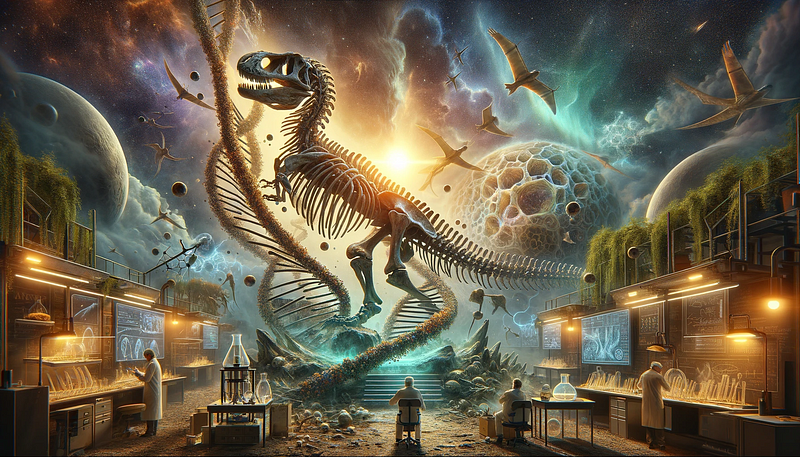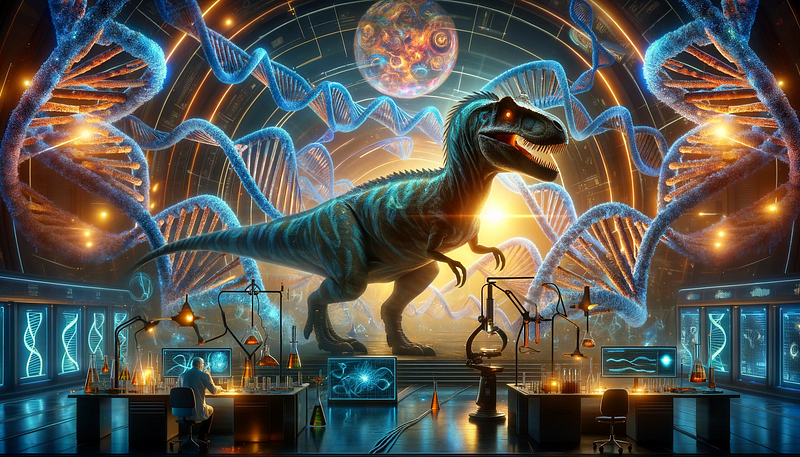Zombies and Dinosaurs: Unraveling Genetic Mysteries
Written on
Zombies 101: Resurrecting Dinosaurs
Dinosaurs are some of the most captivating beings to have roamed our planet. Their vast array of sizes, shapes, and adaptations has sparked the curiosity of countless scientists and enthusiasts alike. Yet, despite the wealth of fossil evidence, many aspects of these ancient creatures remain shrouded in mystery. One of the most compelling questions is: what did their genetic material look like, and is it possible to bring dinosaurs back to life?
DNA, or deoxyribonucleic acid, is the fundamental molecule that encodes the genetic blueprint of all living organisms, from simple bacteria to complex humans. By analyzing the DNA of extinct species, we could gain insights into their evolution, physiology, behavior, and ecological relationships.
However, retrieving DNA from dinosaur fossils is far from straightforward; in fact, it might be impossible. During my high school years, I held the belief that we could someday extract DNA from dinosaur remains. Unfortunately, I later discovered that what we refer to as dinosaur bones are not actually intact bones, and we lack any original dinosaur tissues. Consequently, extracting dinosaur DNA from fossils is beyond our reach.

Why is this the case? The answer lies in the fossilization process, which involves the preservation of an organism's remains within sedimentary rocks. Typically, this occurs when an organism dies and becomes buried under layers of sediment such as sand, mud, or ash. Over time, these sediments solidify into rock, while the organic materials decompose and are gradually replaced by minerals. This results in a mineralized replica of the organism's original structure, devoid of its organic components.
Thus, what we identify as dinosaur bones are essentially mineral casts, lacking any cellular material, proteins, or DNA. DNA is a delicate molecule that degrades over time, particularly in harsh environmental conditions. It is estimated that DNA can only persist for a few thousand years under optimal circumstances, which include low temperatures, minimal humidity, and high salinity. Given that dinosaurs existed millions of years ago, their fossils have been subjected to heat, moisture, bacteria, and chemical reactions that would obliterate any remnants of DNA.
Nonetheless, there is a glimmer of hope. Researchers believe that they can reverse-engineer birds to create species reminiscent of dinosaurs in laboratory settings. How is this achievable? The answer lies in the evolutionary link between birds and dinosaurs.
Birds are modern-day descendants of a specific group of dinosaurs known as theropods, which included notable species like Tyrannosaurus rex and Velociraptor. These theropods possessed feathers, hollow bones, and three-fingered limbs—characteristics that are also present in contemporary birds. Over millions of years, theropods evolved into smaller, more agile forms, ultimately leading to the emergence of true birds. Today, birds represent the most diverse and widespread class of vertebrates, boasting over 10,000 species.
As birds are the closest living relatives of dinosaurs, they carry remnants of their genetic heritage. By studying and comparing the genetic material of birds and reptiles, scientists can pinpoint the genes responsible for the differences and similarities between the two groups. For example, researchers have identified genes that regulate the development of feathers, scales, teeth, and tails in both birds and reptiles. By manipulating these genes, scientists can modify the appearance and function of these traits in birds, making them more akin to dinosaurs.
For instance, researchers have successfully engineered chicken embryos to possess teeth, snouts, and elongated tails by inhibiting the genes that typically suppress these features in birds. Similarly, they have induced the development of scales in chicken embryos by activating the genes that ordinarily produce feathers. These experiments indicate that the genetic potential for dinosaur-like features still exists within birds and can be unleashed through DNA modification.
However, creating bird species that resemble dinosaurs is not synonymous with resurrecting true dinosaurs. Numerous factors influence an organism's development and behavior, including environmental conditions, interactions with other species, and random mutations over time. Additionally, ethical and practical considerations must be addressed before embarking on attempts to create and nurture dinosaur-like entities in laboratories. Thus, while reverse-engineering birds presents an intriguing and promising area of research, it is not a viable means of bringing dinosaurs back to life.

In Summary
The pursuit of dinosaur DNA is fraught with challenges and complexities. Although we may never extract DNA from actual dinosaur fossils, we can investigate the genetic material of their living descendants, birds. Through comparative analysis and genetic manipulation of bird and reptile DNA, we might create species reminiscent of dinosaurs in laboratory environments. However, this endeavor is not equivalent to creating authentic dinosaurs and involves a host of scientific, ethical, and practical hurdles. Therefore, the most effective way to understand dinosaurs is through fossil studies, allowing us to appreciate their diversity and lasting impact on our natural world.
The first video titled "I Overpopulated The Earth With Zombie Dinosaurs" explores a fictional scenario where dinosaurs are resurrected, leading to an overpopulation of these prehistoric creatures. The video delves into the implications of reviving such species and the fantastical elements of dinosaurs coexisting with modern life.
The second video, "Comic Review | Marvel Zombies: Black, White & Blood #4," provides a creative take on the zombie genre, showcasing how dinosaurs and zombies can intertwine in comic narratives. This review highlights the imaginative storytelling that brings together themes of resurrection and adaptation within the comic universe.